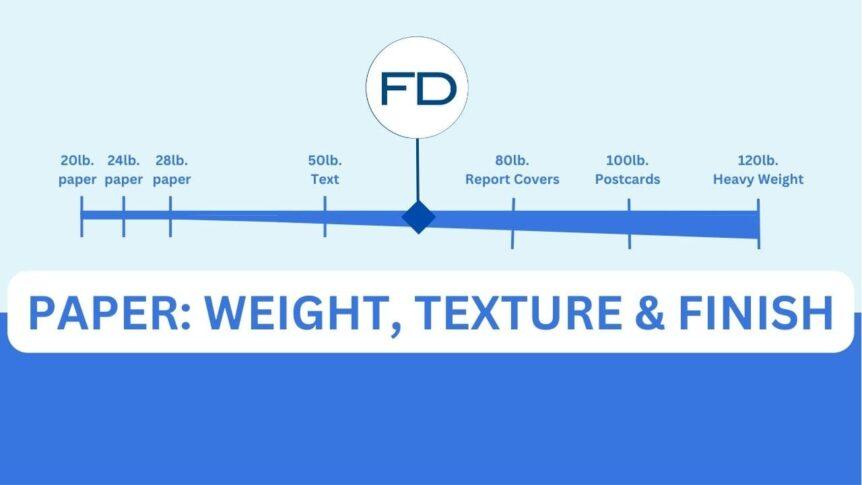Final in the series: While designing your Direct Mail piece, you’ve now taken into account your copy, selected a piece size and envelope, and decided on a color palette. To complete your design, you have one more decision to make your design pop:
Choosing The Right Paper Weight For Your Piece
A direct mail piece’s visual and tactile impact on the recipient is heavily influenced by the weight, texture and finish of the paper you choose. Using the right paper can help enhance the impact of the message you are trying to convey.
Paper Weight: The weight of paper refers to its thickness. Typically measured in pounds, the higher the number, the thicker the sheet.
Finish: While there are many choices of paper weights and finish, in Direct Mail there are 5 common options:
- Gloss: A shiny stock, it ensures images appear in high definition, and adds a layer of protection. It’s perfect for all mail types, especially brochures and postcards.
- Satin: Exuding a luster similar to gloss, it reflects less light. Producing sharp and vivid colors, it also has the durability to withstand years of handling.
- Soft Touch: Use to create a soft, velvety texture, with colors appearing more polished and sophisticated.
- Uncoated: Available in a variety of textures, they can provide an elegant look. This stock is great for all mail pieces.
Texture: Related to Finish, paper can have a pronounced texture:
- Laid paper is specially manufactured with textured lines on its surface.
- Linen paper has a similar finish as Laid paper, but this paper has textured lines on the surface of the sheet that are finer and more regular than those that appear on a laid finish stock.
Paper Weight
These qualities combine to define the different paper stocks most commonly used in Direct Mail today:
Text: Available with either a coated or uncoated finish, Text is a lightweight paper often used for letters, publication interiors and sell sheets. Common text weights are:
- 50# – Standard light weight paper
- 60# – One grade heavier than standard
- 70# – thicker and less transparent
- 80# or 100# are pretty thick. Depending on what you want to mail, they can be a good choice. If you are choosing a text stock for a self-mailer, keep in mind that you need to be at 80# or more to withstand the mail equipment without tearing.
Bond: Generally used for letters, bond papers must be able to run through laser printers. Common stocks include:
-
-
- 20# – A standard weight paper
- 24# – The preferred weight for most business papers
- 28# – Heavier paper, less frequently used for letters, but commonly used for envelopes.
-
Cover: Heavy in weight and therefore more rigid, cover stock can be harder to fold. Generally used for publication covers, self-mailers, and postcards, they can have coated or uncoated finishes. Common weights:
- 65# – A lightweight cover stock most common for self-mailers
- 80# – Slightly heavier than 65#, works well for report covers
- 88# – Heavier than 80#, but still considered a lightweight cover
- 100# – Mid-weight cover and is common for postcards
- 120# – considered a heavyweight cover. You do not want to fold this one, so stick with postcards.
Paper Choice Is Critical
As a marketer, you have many options. Paper choice is critical when designing your direct mail piece. Some designs look better on matte, some on glossy stock. Make sure you match it to the message you are looking to convey. Paper weights do matter!
We hope this series helps you get started on your next successful campaign! Our team at Federal Direct is available and eager to talk with you about any and all aspects of your campaign and share our expertise!
Call or contact us today for a free quote!
More resources Forbes Magazine article.
